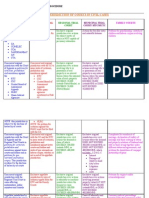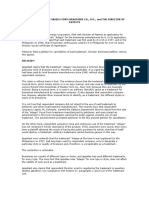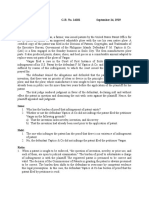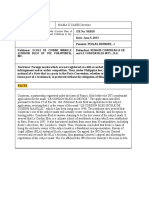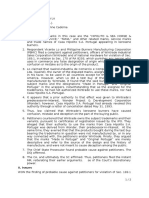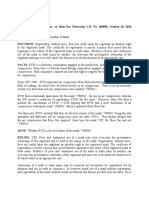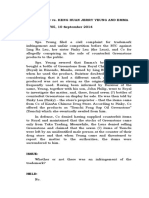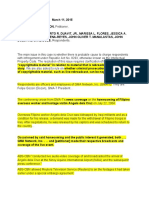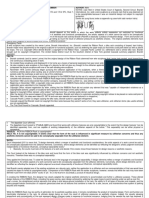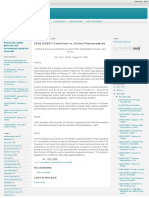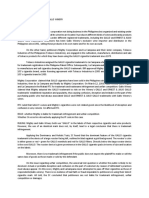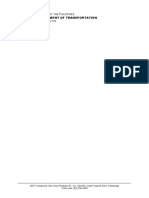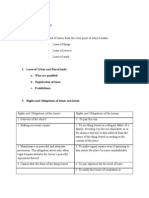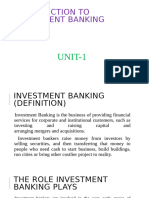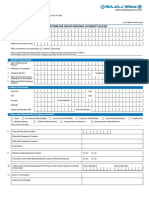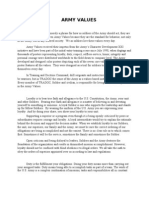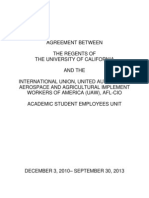Ang Vs Teodoro
Ang Vs Teodoro
Uploaded by
Cherie PastoresCopyright:
Available Formats
Ang Vs Teodoro
Ang Vs Teodoro
Uploaded by
Cherie PastoresOriginal Title
Copyright
Available Formats
Share this document
Did you find this document useful?
Is this content inappropriate?
Copyright:
Available Formats
Ang Vs Teodoro
Ang Vs Teodoro
Uploaded by
Cherie PastoresCopyright:
Available Formats
Ang vs.
Teodoro Facts: Toribio Teodoro at first in partnership with Juan Katindig and later as sole proprietor, has continuously used Ang Tibay both as a trademark and as a trade-name, in the manufacture and sale of slippers, shoes and indoor baseballs sine 1910. He formally registered it as a trademark on September 29, 1915 and as a trade-name on January 3, 1933. Starting in an obscure shop in 1910 with a modest capital of 210php but with tireless industry and unlimited perseverance, Teodoro, then an unknown young man making slippers with his own hands but now a prominent business magnate and a manufacturer with a large factory operated with modern machinery by a great number of employees, has steadily grown with his business ton which he has dedicated the best years of his life. The petitioner, Ana Ang registered the same trademark Ang Tibay for pants and shirts on April 11, 1932 and established a factory for the manufacture of said articles in the year 1937. The RTC ruled in favor of the petitioner, absolving Ana Ang from the complaint on the ground that two trademarks are dissimilar and are used on different and non-competing goods; that there had been no fraud on the use of said trademarks. However, the CA reversed the ruling of the RTC, holding that by uninterrupted and exclusive use since 1910 in the manufacture of slippers, shoes, Teodoros trademark has acquired secondary meaning; that the goods or articles on which the two trademarks are used are similar or belong to the same class; and that the use by Ana Ang (petitioner) of said trademark constitutes a violation of Section 3 and 7 of Act # 666. Hence, the petition. Issue: 1. Whether or not the words Ang Tibay is a descriptive term. 2. Whether or not the words Ang Tibay had acquired a secondary meaning? 3. Whether or not the pants and shirts are goods similar to shoes and slippers within the meaning of Sections 3 and 7 of Act # 666? Ruling: 1. The words Ang Tibay is an exclamation denoting admiration of strength or durability. It is never used adjectively to define or describe an object. Hence, the term is NOT a descriptive word within the meaning of the Trade-Mark Law but rather a fanciful or coined phrase which may properly and legally be appropriated as a trademark or tradename. 2. It is unnecessary to apply the Doctrine of Secondary Meaning in the trademark parlance. Furthermore, this doctrine is to effect that a word or phrase originally incapable of exclusive appropriation with reference to an article on the market, because geographically or otherwise descriptive, might nevertheless have been used so long and so exclusively by one producer with reference to his article. The phrase Ang Tibay being neither geographic nor descriptive, was originally capable of exclusive appropriation as a trademark. In any event, the CAs ruling that the Doctrine of Secondary Meaning be fully sustained is affirmed, because Teodoros long and exclusive use of said phrase with relative to its products and his business, has acquired a propriety connotation. 3. The test employed by the courts to determine whether non-competing goods are or are not of the same class is confusion as to the origin of the goods of the second user. Although two non-competing goods may be classified under two different classes by the Patent Office, because they are deemed not to possess the same descriptive properties, they would nevertheless, be held to belong to the same class if the simultaneous use on them of identical or closely similar trademarks would be likely to cause confusion as to the origin, or personal source of the second users goods. The judgment of the Court of Appeals is affirmed, with costs against the petitioner in the three instances.
You might also like
- Wiggle Factor ReportDocument28 pagesWiggle Factor Reportoszkar69No ratings yet
- Shangrila Case DigestDocument2 pagesShangrila Case DigestAira Alyssa0% (1)
- Ang vs. TeodoroDocument2 pagesAng vs. Teodoroasg_jingNo ratings yet
- Civpro JurisdictionDocument4 pagesCivpro JurisdictionCherie Pastores100% (3)
- Indonesia Fintech Summit 2019 Conference Agenda PDFDocument12 pagesIndonesia Fintech Summit 2019 Conference Agenda PDFjuragankuisNo ratings yet
- Ang v. Teodoro, 74 Phil. 50 (1942)Document2 pagesAng v. Teodoro, 74 Phil. 50 (1942)Paolo Mendioro100% (1)
- Ching vs. Salinas, SR., G.R. No. 161295, 29 Jun 2005Document13 pagesChing vs. Salinas, SR., G.R. No. 161295, 29 Jun 2005Gret HueNo ratings yet
- Angelita Manzano vs. Court of AppealsDocument2 pagesAngelita Manzano vs. Court of AppealsJay Kent Roiles100% (1)
- Francisco Joaquin Vs Franklin Drilon GR NoDocument1 pageFrancisco Joaquin Vs Franklin Drilon GR NoAnna Beatrice TarrosaNo ratings yet
- Digest Romero Vs MaidenDocument2 pagesDigest Romero Vs MaidenLorryDelgado100% (1)
- W Land v. Starwood Hotels, G.R. 222366, December 4, 2017Document1 pageW Land v. Starwood Hotels, G.R. 222366, December 4, 2017enriquemmmNo ratings yet
- 152 Philippine Refining Vs NG SamDocument3 pages152 Philippine Refining Vs NG SamKirsten Denise B. Habawel-VegaNo ratings yet
- Coffee Partners v. San Francisco Coffee and RoasteryDocument2 pagesCoffee Partners v. San Francisco Coffee and RoasteryNenzo Cruz50% (2)
- Joaquin v. DrilonDocument2 pagesJoaquin v. DrilonClarissa Sawali100% (1)
- Pearl & Dean (Phil.), Inc. Vs Shoemart, Inc GR NoDocument2 pagesPearl & Dean (Phil.), Inc. Vs Shoemart, Inc GR NoClaudine Arrabis100% (1)
- Vargas V Yaptico & CoDocument2 pagesVargas V Yaptico & CoPablo Jan Marc Filio100% (1)
- MANZANO Vs CADocument2 pagesMANZANO Vs CAClarissa SawaliNo ratings yet
- 8 Great White Shark V CaraldeDocument3 pages8 Great White Shark V CaraldeKaren De VillaNo ratings yet
- Rosero - Levi Strauss vs. Atty. BlancaflorDocument2 pagesRosero - Levi Strauss vs. Atty. BlancaflorDave Urot100% (2)
- COFFEE PARTNERS, INC. v. SAN FRANCISCO COFFEE AND ROASTERY, INC., G.R. NO. 169504, March 3, 2010Document8 pagesCOFFEE PARTNERS, INC. v. SAN FRANCISCO COFFEE AND ROASTERY, INC., G.R. NO. 169504, March 3, 2010Emil BautistaNo ratings yet
- Mang Inasal v. Ifp Manufacturing CorporationDocument2 pagesMang Inasal v. Ifp Manufacturing CorporationShie La Ma RieNo ratings yet
- PHILIPPINE NUT INDUSTRY V Standard Brands INCDocument2 pagesPHILIPPINE NUT INDUSTRY V Standard Brands INCjj martinezNo ratings yet
- In-N-Out Burger vs. SehwaniDocument3 pagesIn-N-Out Burger vs. Sehwanisimon gibalay100% (1)
- Great White Shark V Caralde DigestDocument2 pagesGreat White Shark V Caralde DigestElainne Encila100% (1)
- Aguas Vs de LeonDocument7 pagesAguas Vs de LeonMickoy CalderonNo ratings yet
- Maguan Vs CA - Patents - EibborDocument2 pagesMaguan Vs CA - Patents - EibborPevi Anne Bañaga FetalveroNo ratings yet
- Ecole de Cuisine Manille, Inc. v. Renaud Cointreau - CieDocument2 pagesEcole de Cuisine Manille, Inc. v. Renaud Cointreau - CieDarlene GanubNo ratings yet
- Philippine Refining v. NG SamDocument2 pagesPhilippine Refining v. NG Samchappy_leigh118No ratings yet
- Chester Uyco v. Vicente LoDocument2 pagesChester Uyco v. Vicente LoDianne Cadorna100% (1)
- Doctrine of Automatic Protection United Feature V MunsingwearDocument2 pagesDoctrine of Automatic Protection United Feature V MunsingwearArah Salas PalacNo ratings yet
- Case Digest Zuneca Pharmaceuticals v. Natrapharm Inc., (G.R. No. 21850, September 8, 2020 IRT - HTMLDocument5 pagesCase Digest Zuneca Pharmaceuticals v. Natrapharm Inc., (G.R. No. 21850, September 8, 2020 IRT - HTMLCharity Romaga100% (2)
- Maglalang Santos VS., McCullough. IPILDocument10 pagesMaglalang Santos VS., McCullough. IPILCareyssa MaeNo ratings yet
- IPL Case DigestsDocument5 pagesIPL Case DigestsEcnerolAicnelavNo ratings yet
- Levi Strauss Vs Toly Lim DigestDocument2 pagesLevi Strauss Vs Toly Lim DigestAthena Nedamo100% (1)
- 018 - Levi Strauss (Phils) V Tony LimDocument5 pages018 - Levi Strauss (Phils) V Tony LimgabbyborNo ratings yet
- Campbell v. Acuff-Rose Music, Inc.Document1 pageCampbell v. Acuff-Rose Music, Inc.sdfoisaiofasNo ratings yet
- 246 CORPORATION Vs HON. DAWAYDocument1 page246 CORPORATION Vs HON. DAWAYchaNo ratings yet
- 06 - Emzee Foods Inc V Elarfood - Digest AQCarigmaDocument3 pages06 - Emzee Foods Inc V Elarfood - Digest AQCarigmaAndrea Quiogue CarigmaNo ratings yet
- Del Rosario Vs CADocument2 pagesDel Rosario Vs CAFlois SevillaNo ratings yet
- Jessie G. Ching V. William M. Salinas, SR., Et. Al. G.R. No. 161295, June 29, 2005, CALLEJO, SR., J.: FactsDocument4 pagesJessie G. Ching V. William M. Salinas, SR., Et. Al. G.R. No. 161295, June 29, 2005, CALLEJO, SR., J.: FactsgailacdNo ratings yet
- Chuanchow Soy v. Director of PatentsDocument2 pagesChuanchow Soy v. Director of PatentsJustine Joy PabloNo ratings yet
- 7 - Fredco Mfg. Corp. vs. Pres and Fellows of Harvard CollegeDocument3 pages7 - Fredco Mfg. Corp. vs. Pres and Fellows of Harvard CollegekarleneNo ratings yet
- B2E Mang Inasal Philippines Inc. v. IFP Manufacturing Corporation, GR 221717, 19 June 2017, Third Division, Velasco Jr. (J) - ROMERO PDFDocument2 pagesB2E Mang Inasal Philippines Inc. v. IFP Manufacturing Corporation, GR 221717, 19 June 2017, Third Division, Velasco Jr. (J) - ROMERO PDFloschudent100% (1)
- E.Y. Industrial Sales Inc. vs. Shen Dar Electricity G.R. No. 184850, October 20, 2010Document2 pagesE.Y. Industrial Sales Inc. vs. Shen Dar Electricity G.R. No. 184850, October 20, 2010Christian John Dela Cruz100% (1)
- KHO Vs CADocument3 pagesKHO Vs CAcarloNo ratings yet
- Emerald Garment Vs CA DigestDocument3 pagesEmerald Garment Vs CA DigestJerome Morada67% (3)
- Maguan vs. Court of AppealsDocument2 pagesMaguan vs. Court of AppealsidemsonamNo ratings yet
- 1 PEARL DEAN (PHIL.), INCORPORATED v. SHOEMART, INCORPORATED, AND NORTH EDSA MARKETING, INCORPORATEDDocument2 pages1 PEARL DEAN (PHIL.), INCORPORATED v. SHOEMART, INCORPORATED, AND NORTH EDSA MARKETING, INCORPORATEDErika Pineda50% (2)
- Pascual Godines Vs CADocument2 pagesPascual Godines Vs CAJay Kent Roiles100% (3)
- CRESER PRECISION SYSTEMS, INC. vs. COURT OF APPEALS G.R. No. 118708. February 2, 1998Document2 pagesCRESER PRECISION SYSTEMS, INC. vs. COURT OF APPEALS G.R. No. 118708. February 2, 1998Michelle Joy Itable100% (1)
- Case Digest Co vs. Yeung - Trademark InfringementDocument2 pagesCase Digest Co vs. Yeung - Trademark InfringementMa LaneyNo ratings yet
- ABS-CBN v. Gozon DigestDocument6 pagesABS-CBN v. Gozon DigestGilbert John Lacorte0% (1)
- Levi Strauss & Co. vs. Clinton ApparelleDocument4 pagesLevi Strauss & Co. vs. Clinton ApparelleCoco Loco75% (4)
- 08 Brandir Intern., Inc. v. Cascade Pac. LumberDocument2 pages08 Brandir Intern., Inc. v. Cascade Pac. Lumberaspiringlawyer1234100% (1)
- Jose V Barrueco DigestDocument1 pageJose V Barrueco DigestMidzmar KulaniNo ratings yet
- Case Digest No. 23Document3 pagesCase Digest No. 23Nikki P. GabianeNo ratings yet
- 13 Parke Davis V Doctors Pharma 124 SCRA 115 PDFDocument3 pages13 Parke Davis V Doctors Pharma 124 SCRA 115 PDFSilver Anthony Juarez PatocNo ratings yet
- Ching vs. Salinas G.R. No. 161295, June 29, 2005Document2 pagesChing vs. Salinas G.R. No. 161295, June 29, 2005Ro CheNo ratings yet
- GR 115758 DigestDocument1 pageGR 115758 DigestJan Mark WongNo ratings yet
- Mighty Corporation V e and J Gallo WineryDocument1 pageMighty Corporation V e and J Gallo WineryGabbie DionisioNo ratings yet
- 02 Esso Standard Eastern, Inc. V CADocument2 pages02 Esso Standard Eastern, Inc. V CAeieipayadNo ratings yet
- Societe Des Produits Nestle Vs CADocument5 pagesSociete Des Produits Nestle Vs CAYanilyAnnVldzNo ratings yet
- Ang vs. TeodoroDocument2 pagesAng vs. TeodoroDonna DumaliangNo ratings yet
- Atty. CPP - AR - 27 28 June 2024Document2 pagesAtty. CPP - AR - 27 28 June 2024Cherie PastoresNo ratings yet
- Sample Endorsement LetterDocument1 pageSample Endorsement LetterCherie PastoresNo ratings yet
- 20211111.LOI For Gardenia (Fuel)Document1 page20211111.LOI For Gardenia (Fuel)Cherie PastoresNo ratings yet
- Letter TemplateDocument1 pageLetter TemplateCherie PastoresNo ratings yet
- DOTr Letter FormatDocument1 pageDOTr Letter FormatCherie PastoresNo ratings yet
- Holographic WillDocument1 pageHolographic WillCherie PastoresNo ratings yet
- Lease BartipsDocument3 pagesLease BartipsCherie PastoresNo ratings yet
- CHAPTER 1 Notes TaxDocument6 pagesCHAPTER 1 Notes TaxCherie PastoresNo ratings yet
- Presentation On Business Law (11) : Shikha Kumari Imba, 23 8 SemDocument22 pagesPresentation On Business Law (11) : Shikha Kumari Imba, 23 8 SemVarsha PandeyNo ratings yet
- Investment BankingDocument54 pagesInvestment BankingBhavya BajajNo ratings yet
- Liban vs. GordonDocument3 pagesLiban vs. GordonFred Michael L. GoNo ratings yet
- Fundamental RightDocument26 pagesFundamental RightAbhayNo ratings yet
- Math 10 - Q 4 - SLM - Module 4Document9 pagesMath 10 - Q 4 - SLM - Module 4Ailen CeniaNo ratings yet
- Cax AcsDocument3 pagesCax AcsJuan Fer Eguez BNo ratings yet
- Advertisement No. 08-2024Document4 pagesAdvertisement No. 08-2024UsamaKhattakNo ratings yet
- BADAC Consolidated Information ReportDocument4 pagesBADAC Consolidated Information ReportMalipampang San Ildefonso100% (2)
- Sager RosserWeberWilsonandHegel - theoriesofModernBureaucracyDocument23 pagesSager RosserWeberWilsonandHegel - theoriesofModernBureaucracyIshfa UmarNo ratings yet
- Law and ItDocument33 pagesLaw and ItFaaiz siddiquiNo ratings yet
- 5 Digital Transformation Challenge Unique To Consulting PDFDocument15 pages5 Digital Transformation Challenge Unique To Consulting PDFmy9zzrtt6mNo ratings yet
- 15 00 17 22 05 2567 GED-Social-Studies-Test-1Document15 pages15 00 17 22 05 2567 GED-Social-Studies-Test-1Krishita ThakralNo ratings yet
- Claim Form For Group Personal Accident PoliciesDocument4 pagesClaim Form For Group Personal Accident PoliciesanujaNo ratings yet
- NIT No.32, CMD-1, F618Document25 pagesNIT No.32, CMD-1, F618Tanuj ShriNo ratings yet
- Enrone Case Study FindingsDocument6 pagesEnrone Case Study Findingszubair attariNo ratings yet
- Ak MCQDocument130 pagesAk MCQanand vishwakarmaNo ratings yet
- Army ValuesDocument5 pagesArmy ValuesSteven HarvilleNo ratings yet
- Cashflow StatementDocument2 pagesCashflow StatementChip choiNo ratings yet
- Certificate of Non-Forum Shopping - ImportanceDocument1 pageCertificate of Non-Forum Shopping - ImportanceDO SOLNo ratings yet
- Modern British History Reading ListDocument9 pagesModern British History Reading ListSemBabaNo ratings yet
- Minutes of MeetingDocument22 pagesMinutes of Meetingmichelle.mulaNo ratings yet
- Bill ClintonDocument9 pagesBill ClintonFatokun TomiwaNo ratings yet
- Maruti Udyog LTD: Financing StrategyDocument6 pagesMaruti Udyog LTD: Financing StrategyAbhishek Mukherjee0% (1)
- Group Assignment For Proposal WrittingDocument39 pagesGroup Assignment For Proposal WrittingKeyd MuhumedNo ratings yet
- Ocean Thermal Energy Corp V C Robert Coe III Et Al Cacdce-19-05299 0203.0Document2 pagesOcean Thermal Energy Corp V C Robert Coe III Et Al Cacdce-19-05299 0203.0mkuriloNo ratings yet
- Legal Writing Case Digests VALE CRUZDocument61 pagesLegal Writing Case Digests VALE CRUZMichelle Vale CruzNo ratings yet
- Summary of The Fire Code of The PhilippinesDocument2 pagesSummary of The Fire Code of The Philippinesglenn cardona100% (1)
- Contract UAW 2865 UC 2010 2013Document45 pagesContract UAW 2865 UC 2010 2013Cody TrojanNo ratings yet



